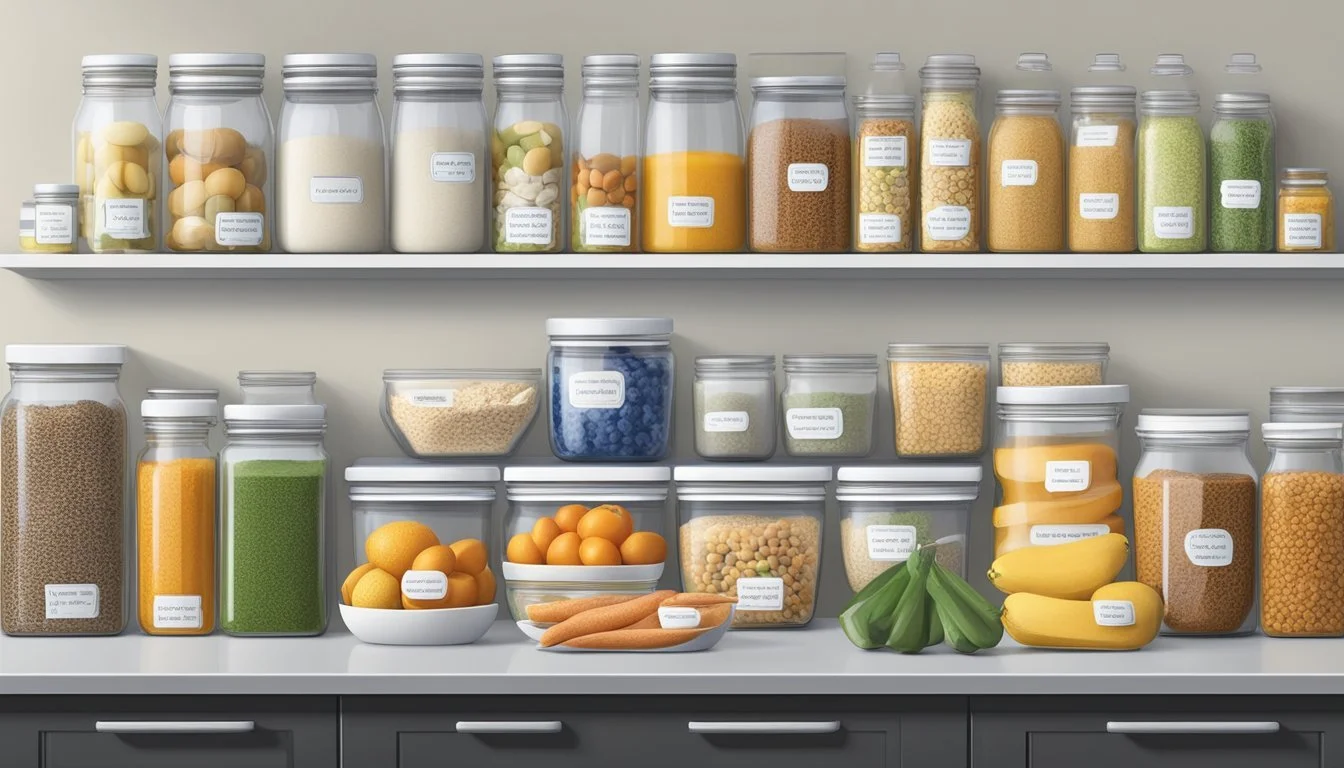Organizing Your Kitchen for a Mind Diet
Streamlined Strategies for Healthful Eating
Organizing your kitchen is an essential step towards committing to a diet centered around brain health. A kitchen designed with wellness in mind can simplify the process of making healthy choices and lead to a sustainable, healthy lifestyle. When healthy options are made readily accessible and convenient, they become the natural choice. This straightforward approach allows individuals to select foods that not only nourish the body but also support cognitive function and overall mental well-being.
A mind diet emphasizes foods known to contribute to brain health, such as leafy greens, nuts, berries, beans, whole grains, and lean proteins. By keeping these items in an organized and visible place in the kitchen, one can increase the likelihood of incorporating them into daily meals. Conversely, relegating less healthy, processed foods to less accessible storage areas can decrease the chances of their consumption. This strategic placement aligns with an environment that encourages a balanced diet and supports brain health.
In addition to a well-arranged environment, maintaining a well-stocked kitchen with these brain-boosting items ensures that the necessary ingredients for a healthy meal are always within reach. This can help fend off the temptation to opt for convenience foods that may be high in added sugars and unhealthy fats. Prioritizing the availability of nutrient-dense, whole foods is a key component of a diet that fosters cognitive health and bolsters the foundations of a mindful, healthy lifestyle.
The MIND Diet Basics
The MIND Diet is a fusion of the Mediterranean and DASH diets, strategically designed to promote brain health and reduce the risk of Alzheimer's Disease through a focus on specific food groups.
Understanding the MIND Diet
The MIND Diet stands for "Mediterranean-DASH Intervention for Neurodegenerative Delay" and aims at slowing cognitive decline. Researchers established this diet based on foods scientifically linked to improved brain function and decreased neurodegeneration. They recommend regular consumption of brain-boosting foods while limiting those detrimental to cognitive health.
Key Foods for Brain Health
The MIND Diet emphasizes particular foods known to support brain health:
Leafy greens and vegetables: Aim for at least six servings per week of leafy greens such as kale and spinach, as well as a variety of other vegetables.
Nuts: Include nuts, which are high in healthy fats, for most days of the week.
Berries: Berries, especially blueberries, should be included at least twice a week.
Whole grains: Individuals should strive for three servings a day of whole grains like oatmeal, quinoa, and brown rice.
Olive oil: Olive oil is recommended as the primary cooking oil, rich in monounsaturated fats.
Fish: Seafood, which is high in omega-3 fatty acids, should be eaten at least once a week.
Poultry: Incorporate poultry into meals at least twice a week.
Beans: Aiming for beans every other day can provide protein and fiber.
In this diet, the focus is not only on what to include but also on healthy cooking methods that maintain the nutritional integrity of these foods. Accordingly, it encourages the preparation of meals that incorporate these elements in a balanced and brain-healthy manner.
Decluttering Your Kitchen Space
Organizing the kitchen is instrumental for those following a Mind Diet, as it encourages the preparation of healthier meals and reduces the temptation of unhealthy choices. Decluttering improves the kitchen's functionality and supports dietary goals.
Minimizing Unhealthy Options
To align with the Mind Diet, individuals should begin by removing unhealthy foods that do not contribute to brain health. This action clears the way for nutritious alternatives that support cognitive function.
Purge Non-Essentials: Evaluate the contents of the pantry, refrigerator, and cabinets. Any food items high in sugar, trans fats, or preservatives should be donated or disposed of, as these do not align with the Mind Diet principles.
Rearrange Strategically: Place healthier options at eye level and within easy reach. By applying the "out of sight, out of mind" principle, this ensures that healthier food choices are more accessible, while less beneficial options are stored away or removed entirely.
Enhancing Kitchen Flow
A well-organized kitchen promotes efficiency and enjoyment in meal prep, which is vital for those on a Mind Diet who often prepare meals with fresh, whole ingredients.
Simplify Workspaces: Keep counters clear except for frequently used appliances and essentials. Dedicate specific areas for food preparation, cooking, and storage to streamline the cooking process.
Evaluate Utensils and Gadgets: Only keep tools that assist in the preparation of Mind Diet recipes. Multipurpose items are preferable as they reduce clutter and serve various functions, aiding in the maintenance of a simplified, organized kitchen.
Organized Storage Solutions
When pursuing a Mind Diet, having an organized kitchen with proper storage solutions can greatly enhance one's ability to maintain dietary habits. Specific storage techniques and tools aid in preserving food quality and nutrient integrity.
Food Storage Best Practices
Clear Containers: A chef’s allies in the kitchen are clear, stackable storage containers. They enable one to quickly identify contents, which simplifies inventory checks and reduces the likelihood of overlooking items before they spoil.
Labels: Labels are paramount for maintaining an organized pantry and refrigerator. They should provide the following:
Content description
Prepared-on date
Expiration date
Airtight Containers: These containers should be used especially for grains, nuts, and seeds, critical components of the Mind Diet. Such containers are instrumental in maintaining freshness and extending shelf life.
Maximizing Freshness
Crisper Drawers: To maintain the crispness and vitality of fruits and vegetables, the refrigerator’s crisper drawers should be utilized effectively. It’s advisable to:
Keep fruits and vegetables in separate drawers to prevent ethylene sensitivity.
Adjust humidity settings according to what is stored (high humidity for leafy greens, low for fruits).
Expiration Dates: Regular monitoring of expiration dates is essential. One should arrange items in the pantry and refrigerator so that products with earlier expiration dates are used first, following the first-in, first-out principle.
Ensuring that storage solutions are routinely assessed and adjusted as necessary will maintain an efficient and health-supportive kitchen environment.
Essential Kitchen Tools
In preparing meals for a MIND diet, one must have reliable kitchen tools at hand. The right selection of tools can make the process efficient and even enjoyable.
Selecting Versatile Utensils
When stocking a kitchen with utensils, one should focus on versatility and necessity. The basics include:
Spatulas: For turning and flipping.
Spoons: Both slotted and solid for stirring and serving.
Whisks: Essential for mixing and emulsifying.
Each utensil should serve multiple purposes. For instance, silicone spatulas are not only great for scraping bowls, but they can also handle high-heat cooking.
The Role of Appliances
The efficiency of a kitchen often relies on the quality and use of its appliances. Key appliances for the MIND diet include:
Blender: Crucial for smoothies and pureed soups rich in vegetables and nuts.
Food Processor: For quickly chopping vegetables and making nut-based spreads.
Mason jars are not appliances, but they play a critical role in organization and storage. They are perfect for storing prepped ingredients, homemade dressings, and more, ensuring ingredients are fresh and easy to reach.
Strategies for Mindful Cooking
Incorporating mindful cooking into your routine sets a foundation for preparing meals that align with the Mind Diet, optimizing cognitive health through attentive food choices and preparation techniques.
Prepping for Healthy Meals
One begins their journey toward mindful cooking by setting the stage for healthy meal prep. Individuals arrange their kitchens to ensure easy access to the staples of the Mind Diet such as olive oil, garlic, onions, spices, and herbs. Achieving this entails:
Organizing Ingredients: Place healthy options at the forefront, making them the easiest choice when cooking.
Setting the Right Tools: Keep chopping boards, blenders, and containers within reach to simplify the preparation process.
Adopting Mind Diet Recipes
Mindful cooking also involves the careful selection of recipes that emphasize the Mind Diet's principles. When adopting Mind Diet recipes, chefs focus on:
Integrating Key Ingredients: Prioritize the use of olive oil as the main cooking fat, and include garlic and onions for their potential anti-inflammatory properties.
Herbs & Spices: Generously season with a variety of herbs and spices for flavor without the added sodium.
Each recipe is an opportunity for individuals to engage with their food, making health-conscious decisions that benefit cognitive function and overall well-being.
Reducing Food Waste
Minimizing food waste is crucial in a Mind Diet-focused kitchen. Effective strategies include utilizing leftovers and practicing proper food rotation, both of which ensure that fresh foods like vegetables, fruits, and whole grains such as amaranth and quinoa are used judiciously before spoiling.
Utilizing Leftovers Efficiently
Turning leftovers into new meals is both economical and beneficial for reducing waste. Cooked amaranth or quinoa, for instance, can be transformed into hearty pilafs or added to soups. One can repurpose cooked vegetables and fruits into purees or compotes, which enrich the nutritional value of various dishes. This approach ensures that all edible parts of leftovers contribute to the diet without unnecessary wastage.
Ideas for repurposing leftovers:
Cooked quinoa enhanced with chopped vegetables for a fresh salad
Amaranth added to smoothies for a nutritional boost
Vegetable scraps used to make stock
Proper Food Rotation
Ensuring that foods are consumed in sequence of their purchase dates plays a pivotal role in reducing waste. A "first in, first out" approach is recommended; one should organize the refrigerator and pantry by placing older items in front, where they are visible and accessible. Always store newer purchases towards the back.
Food rotation techniques:
Labels: Mark each food item with the date of purchase.
Areas: Assign specific areas for newly bought and older produce.
Through these methods, individuals maximize the use of available foods like leafy greens, berries, and grains, securing their dietary plans and minimizing waste.
Nutritional Information and Labeling
When organizing a kitchen for a mind diet, understanding nutritional labels is crucial for selecting brain-boosting foods, and ensuring food safety is essential to avoid the detrimental effects of expired or contaminated foods.
Understanding Nutrient Labels
Nutritional labels provide detailed information about the nutrients in food products. The Food and Drug Administration (FDA) stipulates that nutrient amounts, including calories, are relative to the serving size listed on the package. This information is critical for consumers to determine the actual quantity of nutrients they are consuming.
Caloric Content: Indicates the energy provided by the food.
Sugars: Both total sugars and added sugars are listed, with the latter being particularly important to monitor for brain health.
Nutrients: Commonly includes fat, cholesterol, sodium, carbohydrates, fiber, sugars, protein, and certain vitamins and minerals.
Consumers should carefully read labels to manage their intake of nutrients like folate and thiamine, which are vital for cognitive function.
Ensuring Food Safety
Food safety is another paramount concern in the kitchen, involving the proper handling and storage of food items to prevent illness.
Expiration Dates: Heeding expiration dates prevents the consumption of potentially harmful spoiled foods.
Storage: Proper storage minimizes the risk of foodborne illness, with certain foods requiring refrigeration or airtight containers.
Contamination: Cross-contamination, especially between raw and cooked foods, should be avoided to ensure the safety of the food being consumed.
It's essential for individuals to regularly check the freshness of their food and to understand safe food handling practices.







